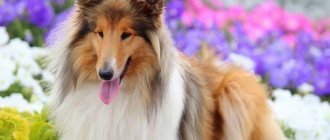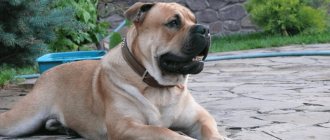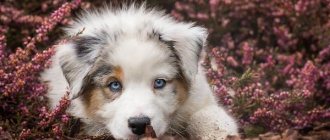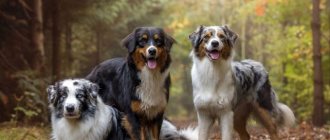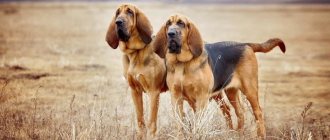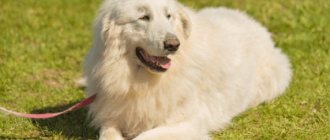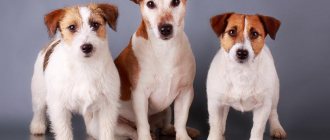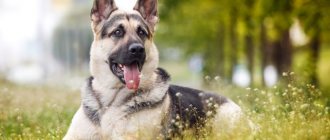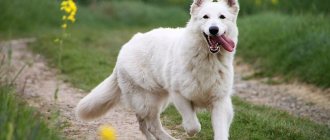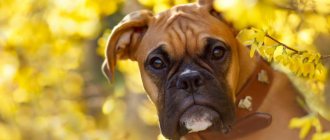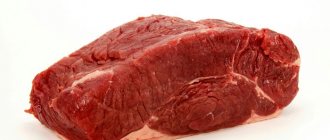Pros and cons of Australian Shepherds
Pros of the Australian Shepherd:
- smart, grasp everything on the fly and are highly trainable;
- very resourceful and can make decisions independently;
- ready to participate in any undertakings;
- hardworking and resilient;
- get along well with children, can babysit and take care of them;
- friendly and devoid of aggression;
- can serve as guides.
Disadvantages of the Australian Shepherd:
- shed heavily;
- require prolonged physical activity;
- cannot sit idle for a long time;
- do not tolerate loneliness well, become attached to one person for life;
- vulnerable and touchy, may show jealousy;
- do not tolerate hot weather well.
Features of character and behavior
The dog has high intelligence and is easy to train. By nature, Ausiyas are companions, and often show excessive care and attention to their owner. For this they were nicknamed Velcro. Many people now own the Australian Shepherd as a pet rather than a working dog. But the instincts of representatives of this breed manifest themselves very powerfully and it is necessary to understand that the breed is a working, herding breed. Then you will be able to choose the right course of behavior with your pet and determine the education system.
It is very important to consider the dog's activity. This breed has a lot of energy and needs to be released somewhere. If the animal does not receive the required amount of active exercise, this may affect its character. In this case, they often fall into a state of apathy and even depression.
Advantages
- The main advantage of the breed can be considered exceptional loyalty. The dog is very attached to its owner and often ignores strangers. A stranger will not cause an aggressive reaction, but an Aussie will not run away to get acquainted either. They get along well with children, take care of and protect them. The same applies to other domestic animals, and is due to herding instincts.
- It is worth understanding that the main activity for the Australian Shepherd is coordinating the movement of livestock, so they are very inventive. Dogs are able to think through multi-step plans and carry them out consistently, for example, to get to a treat or get out of the pen. When performing the same type of tasks, the animal quickly begins to get bored and may act out or show stubbornness.
- Due to their high intelligence, Aussies are excellent working dogs. They are used as companions for people with disabilities. Among the representatives of the breed, guard dogs and rescue dogs are often found. They are often used in law enforcement agencies as bloodhounds.
- Representatives of this breed, for the most part, are not aggressive. They will not harm another animal or person, but they may demonstratively “pinch” the legs, as they are used to guiding herds. Very brave and selfless, they are not afraid to get into a fight, but they do this in extremely rare cases.
Flaws
- The main disadvantage of the breed will be the need for early socialization. In the absence of constant contact with humans, the animal can become aggressive and withdrawn. In principle, even adult individuals quickly become affectionate with proper treatment, and easily get used to society.
- If there is a lack of active walks, Aussies may begin to misbehave, chew on objects, and bark . Or, on the contrary, fall into a state of apathy and become gloomy. The animal has a strong possessive instinct and can zealously defend it. Moreover, it can manifest itself both in relation to territory and an object, and in relation to a person. The dog may become jealous of other people or animals and try to get rid of the irritant.
Description of the breed
The Australian Shepherd is easy to recognize by its appearance. Her conformation is similar to that of a Border Collie, and her distinguishing feature is her well-built, muscular body with a short tail, fluffy coat, and bright eyes with an incredibly conscious gaze.
Bitches look a little sleeker and more graceful than males. But they are not fine-boned.
Head
Large in size, but does not seem bulky in relation to the body.
The skull has a slight rounding, the forehead can be either flat or rounded. A bump on the back of the head is acceptable, but not pronounced. The depression between the nose and forehead is clearly visible. The line of the cranial vault is parallel to the bridge of the nose.
The muzzle is of medium length and has the shape of a cone, gradually tapering from the base to the bridge of the nose.
The nose is well pigmented. Its color depends on the color of the dog. A black lobe can be found in dogs with coats of a similar color or with marbled blue coats. Brown lobes are found in red and merle Aussies. Small splashes of pink are also acceptable on it. They should not account for more than a quarter of the entire area of the lobe.
The jaws are strong, with a scissor or pincer bite. If the dog is overshot or undershot by three millimeters, the dog will be disqualified.
The teeth are white, in a complete formula that numbers forty-two teeth. Twenty of them are located on the upper jaw, and the remaining twenty-two are located on the lower jaw. Ideally, all teeth should be in place. But losing a few of them due to injury does not disqualify a dog.
Eyes
Almond-shaped, with a medium rise. The color of the iris can be any: brown, hazel, green, blue. Marbling or inclusions of other shades are allowed. A different color of the iris in one animal is not considered a defect. Dogs with black and marbled blue fur have dark “glasses” around their eyes. In red and marbled red dogs it is dark brown.
The Australian Shepherd's gaze is conscious and expressive. She always watches with interest the person and what is happening around her.
Ears
In the shape of a small triangle with slightly rounded ends. They are located high, but not far from each other. Lateral placement is also allowed. But then the end of the ear should be directed forward. The ears are in a semi-erect position. When the dog is excited or alert, they rise. Completely drooping or erect ears are considered a disqualifying fault.
Neck
Well muscled, short in length, with a bend at the nape. Sits firmly on the shoulders.
Frame
Strong, with well-developed muscles. The width of the front is the same as the back.
The back is wide, with a straight topline, which after the pelvis passes into a slightly sloping croup.
The chest is shallow, with clearly visible relief. The lowest point is at the same level as the elbow joint. The ribs are elongated and have a regular rounded shape.
The belly does not sag, is tucked in and has a moderate curve.
Tail
Aussies have two types of tail - long and short, up to ten centimeters in length. The second option will be noticeable even at birth. The puppy's tail will be short, and this is not considered a defect. Previously, a third type of tail was allowed - docked. But now such a procedure is prohibited in all civilized countries.
Limbs
The forelimbs are characterized by flat shoulder blades that are located a short distance from the withers. The angle of inclination of the blades is forty-five degrees. The length of the humerus is equal to the shoulder blade and stands at a right angle. The paws are strong and strong, oval in cross-section. The elbow joint is located in the middle of the segment between the withers and the ground. During movement, the forearms are perpendicular to the surface. The pasterns are short and have a slight slope. The presence of dewclaws is allowed. The fingers are compactly assembled, the pads are dense, with elastic skin.
The hind limbs are well muscled. A perpendicular line can be drawn between the femur and the axis of the pelvis. The stifle joints are well defined and have a bend in the area of the hock joints. If you look at an Aussie from behind, the shins will be parallel to each other and strictly perpendicular to the surface on which the dog is standing. Hocks are not long. Dewclaws are not acceptable. The toes, both on the forelimbs and on the hind limbs, are gathered into a ball and fit well together.
Gait
The movements of the Australian Shepherd are distinguished by ease and grace. They are quite wide, but this does not affect the animal’s balance.
The fore and hind limbs move parallel to the central axis of the body. The faster the dog moves, the closer it places its paws to the center of gravity of its body. The line of the back remains level during movement. If necessary, the Aussie can change its trajectory at lightning speed. Her innate agility allows her to do this.
Wool
The Australian Shepherd's coat is quite thick. The hair is medium length and quite hard. Most often it is straight, but the standard allows for slight waviness. The cover consists of two types of hair. On top is the guard. It is long and dense, serving as a kind of “umbrella” that protects the dog from precipitation. Under the guard hair there is a densely packed soft and fluffy undercoat. It warms the dog during the cold season.
The undercoat is completely changed twice a year. Its abundance depends on the conditions in which the dog lives. If it is a cool climate, the undercoat will be very dense. If the year is dominated by hot days, it will be more rare. Shedding in the periods after the change of undercoat is characterized as moderate.
The hair on the face, ears and some parts of the limbs is short. There are so-called “feathers” on the body. These are long guard hairs that grow on the back of the forelimbs and the gluteal area. There is a small mane and collar. However, in males they are more pronounced.
Colors
The colors of Australian Shepherds are varied. They are like human fingerprints - they are never repeated. But officially the standard recognizes only four coat colors:
- black;
- marble blue, which is more common than others;
- red;
- red marble.
In all of the above colors, inclusions of white spots are acceptable, but there should not be too many of them. The older the dog gets, the darker its coat will be.
In nature, sable, gold, brindle or graphite colors can be found. But they are not recognized as a standard, so they are considered a defect.
Photos of different colors of Australian Shepherd
Size and weight
The Australian Shepherd is a medium-sized dog breed. At the same time, females are somewhat smaller in size than males. The height of “boys” can be from 52 to 58 centimeters at the withers. The figure for “girls” ranges from 46 to 53 centimeters. Male weight is from 23 to 29 kilograms. Females - from 18 to 25.
Distinctive features
- The eyes
are the main distinguishing feature of the Aussie. The almond shape, expressiveness and pigmented rim around the eye win the hearts of dog breeders. Quite often there are individuals with heterochromia (eyes of different colors). - The head is
proportional, without skin folds. Neat elongated shape, parallel lines, flat or oval forehead. - The ears
are triangular in shape and are not cropped. Set on high, assume a standing position when the dog is interested. - The bite
is scissor, but the exterior is also allowed to have a straight bite. The teeth are strong and milky in color. - The tail
is often docked. In its natural state, the tail is also shortened. - The paws
are strong and slightly elongated in relation to the body. The joints are movable, the fingers are elongated. - The coat
is long, straight or slightly wavy, with a thick undercoat.
Coloration can vary, but there are 4 generally accepted ones: red, black, red or blue merle
. White inclusions are allowed, but not dominant in color. Mandatory characteristic – pigment along the rim of the eyelid
Personality of Australian Shepherds
Australian Shepherds were first bred as working dogs, as helpers and loyal friends for farmers and their families. Currently, they are still responsible shepherds and devoted companions, they love to work and are happy to be near their owner.
Aussies are balanced, energetic and active. They are very affectionate and cheerful. Representatives of the breed respond well to training, joyfully meet new tasks and perform them well. It is very important for them that their owner pays attention to them and praises them for their help. If you leave your pet at home alone, he will definitely get bored and begin to spoil things and furniture.
Aussies love children and are great friends with them. But Australians behave somewhat warily with strangers. But they are friendly with other dogs and behave wonderfully at shows and on walks.
More than communication with their owner, these dogs only love active games with him. This is the breed that will happily run outside in rain, snow and slush. She will tirelessly run circles around the stadium or overcome the obstacle course over and over again. And if the owner is present, then the animal’s happiness will know no bounds. By the way, an Aussie is a dog that can “smile” when it sees someone from its family. She has a lot of love for life.
Choosing a puppy, prices
It is not recommended to buy an Australian Shepherd from unknown owners or on the market for the sake of a low price.
There is a high risk of purchasing a sick, outbred animal. In Russia, purebred Aussies are rare; just over fifty representatives of this breed are registered. Almost all of them have excellent pedigrees and awards for meeting standards. The offspring of such sires will cost a tidy sum. If you have plans to participate in exhibitions, then the price for an Aussie will be from 60 to 100 thousand Russian rubles.
For those who just need a friend and companion, there is a good way to save money. You can adopt a puppy with disqualifying defects. Most often, this is a discrepancy between the acceptable color, which does not affect either health or mental abilities.
When choosing a pet from a litter, you should pay attention to its appearance. A not thin, moderately well-fed toddler should be playful, inquisitive, not afraid of strangers, and be active. A wet, cold nose, shiny coat, clear, discharge-free eyes and clean ears indicate good health. It is necessary to carefully examine and palpate the abdomen to exclude the presence of a hernia.
The best age for good adaptation to new conditions and the owner is from one and a half to two and a half months. By this time, the puppy should already have a veterinary passport with notes on the first vaccination and deworming. A written purchase and sale agreement is concluded with the owner, which necessarily provides for a refund clause if the puppy turns out to be unwell. The breeder gives a receipt upon receipt of the money, which becomes proof of the purchase of the puppy.
Many follow the good tradition and take the puppy who is the first to answer their call. This makes a certain sense. Firstly, this will be one of the most active babies, and, secondly, it is believed that he himself chose his owner. Such dogs become loyal and devoted friends for life.
Tips for training and education
The Australian Shepherd has the blood of a natural guard running through its veins. If you do not pay proper attention to training and raising your dog, it may become too aggressive in defending its territory. This behavior should be treated with extreme caution. Aussies are friendly and outgoing by nature and should not be aggressive. Like cowardice, it is considered a deviation in animal behavior.
As soon as the puppy arrives in his new home, explain the rules of behavior to him. First of all, he must learn what he can do and what is strictly prohibited. This line of behavior will allow the “child” to quickly get used to and feel comfortable in a new place.
The dog must understand who his owner is. If you don't show this right away, the smart Aussie will try to take a leadership position in your relationship with her.
This breed is considered to be intellectual. Its mental abilities are great, and the dog can be easily taught any commands. A talented Australian Shepherd will snatch them on the fly. On average, a dog learns a new trick in 30-40 repetitions, which is a very high figure.
It is better to start training at home. First of all, teach your puppy commands such as “stay”, “come to me”, “no”. This will keep him safe on the street. Then the training can be continued in the fresh air. This way you can combine business with pleasure by combining a walk and a workout.
It is very important to give your pet motivation to exercise. After each correctly executed command, praise the dog and give it a treat. Australian Shepherds are very greedy for treats, so they will happily work for treats.
Exercising outside helps your dog improve its concentration. This is how the dog develops the habit of not being distracted by external stimuli. Before you start training, give your pet the opportunity to simply run around, sniff the surroundings and do his dog “business”. Then he will be completely focused on executing your commands.
Do not scold or punish an Aussie if the dog does not understand or refuses to comply with a request. In this matter you need to show persistence and patience. If you yell at your dog, he will become fearful or stubborn. Australian Shepherds are very sensitive and can become upset with their owners.
If you find it difficult to cope with training on your own, then it makes sense to seek help from a professional dog trainer. You can take a general obedience course from an instructor, as well as take separate lessons for working with a dog. Australian Shepherds learn quickly, so a few sessions are often enough.
Training
Working with an Aussie is a pleasure. They are intelligent and grasp new information on the fly. very quickly . For full development, they need frequent and regular training and constant learning of new commands.
It is unlikely that you will be able to raise an Aussie to be a guard dog, but it is easy to raise an athlete dog, a companion dog and a reliable assistant in work on the farm. Based on this, suitable training programs should be selected. Advice regarding these programs may be sought from Aussie breeders or their owners.
Keeping and caring for Australian Shepherds
Aussies have a medium length coat. Shedding occurs profusely and seasonally. If the air in the room where the dog lives is dry, the shedding process takes longer.
It is advisable to bathe your shepherd once a month or when it gets dirty, using special shampoos. If your pet lives outdoors, then in winter he does an excellent job of cleaning his fur by rolling around in the snow. And in the summer you can organize a trip to the river and swim there. After this, the dog must be rinsed with clean running water.
If your pet is kept at home, you can bathe it in the bathroom, after placing a rubberized mat on the bottom so that its paws do not slip off. After water procedures, the wool should be thoroughly wiped with a towel and can be dried with a hairdryer.
It is recommended to brush your Aussie a couple of times a week with a brush or comb. This perfectly removes lost hair and also improves blood circulation. During the molting period, this procedure should be performed more often.
At least once a month, you need to trim your dog's nails using a nail clipper.
A dog’s teeth also need care; you need to monitor their condition and take your pet for preventive examinations to a specialist.
Australians by nature are active and mobile; they can run several tens of kilometers a day, so it is unbearable for them to be in a closed space all day. In order for them to maintain health, good health, and maintain proper muscle tone, shepherd dogs need active games in an open space.
They constantly need to be provided with a variety of physical activity, taught obedience, commands, sports, and training for performances at exhibitions. You won't be bored jogging or cycling with them, and you can safely take them with you on walks, hikes and picnics.
Aussies can also be kept outside, for example, by building a spacious enclosure for her. Australians adapt well to frost, rain and hot weather. But it is important to remember that this dog cannot be chained: it needs the opportunity to move freely.
How to care for an Aussie
Keeping an Australian Shepherd presents the owner with some mandatory requirements.
The dog is quite large, so you need to give it enough space. In a private house outside the city, you can build an aviary and a warm booth. In the apartment you need to find a permanent corner for her away from heating radiators and drafts. The dog needs to prepare a mattress of the right size, a bowl, a drinking bowl, buy toys for fetching, brushing teeth and active games. Otherwise, shoes, wooden products and other necessary items can become toys.
Daily walks 2-3 times a day are necessary for Aussies to maintain health and good fitness. Active games, overcoming an obstacle course, accompanying a runner, skier or cyclist are ideal for spending time together. A mandatory part of the walk should be training new commands and consolidating already acquired skills and abilities.
Frequent walks on asphalt and rocky terrain contribute to the natural grinding of claws. If the soil in the area is soft, then the claws require careful trimming twice a month, since uncontrolled length bends the fingers and adversely affects the gait.
Australians need to comb their fur two to three times a week to prevent mats, dermatitis and parasites. During periods of molting, this procedure becomes daily. It is better to do this with a metal brush or a comb with sparse teeth. The undercoat is easily removed with a slicker. Aussies do not need frequent bathing, just wash their paws after a walk. Washing with shampoo intended for dogs is recommended once a quarter.
Eyes, ears and teeth require careful care and special hygiene. The eyes are wiped with tampons soaked in strong tea leaves. You can use furatsilin solution or chamomile infusion. Ear wax is removed with cotton swabs. For cleaning teeth, they sell special bones and toys, gnawing on which the dog gets rid of plaque.
The number of feedings depends on the age of the dog. Puppies eat 5-6 times a day. As they grow older, food intake is reduced to two times per year.
What is better to choose, dry dog food or natural food, each breeder decides individually. Dry ready-made food is balanced in composition and vitamins. You need to select them no lower than the super-premium category, with a low protein content. They require the presence of clean water next to the feeder. Natural food adds variety to the diet, but it will take time to prepare it daily.
Don't forget that Aussies are famous gourmands. Natural food stimulates their appetite. They eat everything and lick the bowl thoroughly. This is fraught with overeating and obesity, so the portion should be dosed in proportion to age and load.
You can feed any porridge (barley, buckwheat, oatmeal, nis), raw and boiled vegetables and fruits (potatoes, turnips, pumpkin, carrots, apples), low-fat varieties of fish and meat, and healthy vegetable fats. It is a good idea to include cottage cheese and fermented milk products in the diet of young animals, since the growing body needs calcium and potassium.
The list of foods undesirable for consumption should be well known so that your pet does not develop allergies or intestinal damage. These are sweets (sweets, chocolate), carbonated and alcoholic drinks, tubular poultry bones, raw fish and meat, mushrooms, nuts, fried foods.
Aussie food
Commercial food would be an excellent choice for your Aussie's diet. If possible, you should choose premium, super-premium, and holistic food. They contain all the necessary nutrients, vitamins and minerals.
You cannot feed your dog the same food throughout its entire life. Manufacturers produce lines for puppies, adult animals and seniors. There are options for nursing bitches, as well as dogs suffering from certain diseases. They all differ in their composition.
Dry food for the Australian Shepherd is a complete and balanced diet that has been developed taking into account the needs of your four-legged friend. No homemade food can compare with industrial food.
When choosing food for your Aussie, pay attention to its composition. It should contain proteins and fats of animal origin, plant components, and grains. But there shouldn’t be any flavorings or flavor enhancers.
The Australian Shepherd is an active dog breed. It should not be overfed, as obesity is detrimental to the health of the animal. Lack of food will also negatively affect him. Muscle tissue and bones will not be able to develop and form correctly. It is important to maintain not only a sufficient amount of calories, but also a balance of nutrients. And it is almost impossible to provide it with natural products. Therefore, leading veterinarians recommend dry and wet food.
An adult Australian Shepherd should be fed twice a day - morning and evening. They do this after a walk so as not to overload the animal’s gastrointestinal tract. If you decide to feed your pet dry food, then he must always have access to drinking water.
Feeding a dog from a common table is strictly prohibited. This not only creates a bad habit of begging for food, but also negatively affects the health of the animal. Food that is suitable for humans is not suitable for dogs. It contains a lot of salt, sugar and other additives that are harmful to the dog.
Weak spots. How to keep your dog healthy
Proper feeding and proper care are the key to keeping your dog healthy for many years.
Timely vaccinations against viral diseases such as distemper, rabies, Lyme disease will protect her life in case of accidental contact with stray, wild animals and rodents. It is safer to purchase an Australian Shepherd from breeders who have received permission to breed their dog and have undergone health and genetic testing with it. Familiarization with this documentation is not a whim. The fact is that this breed has a predisposition to certain diseases.
For example, if a dog is a carrier of the MDR-1 gene, then mating with the owner of such a gene cannot be carried out. The litter will definitely be sick. This gene is more common in individuals with merle shades. The result of mating will be pure white puppies with genetic defects leading to blindness, deafness and other problems.
The weak points in Aussie health are the joints, especially the elbows and hips. Dysplasia leads to arthritis and lameness. It may be congenital. It can only be treated with surgery and large doses of antibiotics.
Common diseases in Australian Shepherds: oncology, demodicosis, epilepsy, eye diseases, allergies. Some deworming medications cause an allergic reaction so severe that it can cause the death of your pet. Consultation and observation by veterinarians is also necessary when using medications against ticks and fleas.
Preventive examinations of your Aussie twice a year will keep her healthy and active for longevity. After all, a disease is always easier to prevent than to treat.
Health and illness
If you provide your Australian Shepherd with decent nutrition, a high level of physical activity and care, then it may well become a long-liver. And in order to avoid most diseases that are deadly for dogs, it is necessary to give your pet all the necessary vaccinations in a timely manner.
Most herding breeds are prone to developing juvenile cataracts. Aussies were no exception. In addition, they may be more likely to suffer from the following diseases:
- autoimmune diseases, including allergies;
- vision problems, optic nerve dystrophy;
- epilepsy;
- dysplasia of the hip joints;
- malignant tumors;
- skin diseases, demodicosis.
Dogs with a merle coat color are prone to blindness and deafness. This defect is congenital and may occur due to a recessive gene that is associated with this color, as well as hearing and vision. To avoid such troubles, breeders do not cross two merle-colored individuals. Otherwise, the risk of giving birth to completely deaf and blind puppies increases.
Varieties of colors
The following colors are allowed by the standard:
- Black.
- Blue Merle (blue merle).
- Red.
- Red Mer (red marble).
Historical reference
Historians have studied the origin of the Australian Shepherd literally up and down. But they were never able to reach a consensus on this issue. It is generally accepted that the history of the appearance of the Aussie originates in Australia, and is associated with the name of Eliza Forlong, but the first representatives of this breed were bred in America.
Eliza Forlong settled with her family in eastern Australia in the early nineteenth century. They organized a farm and began raising sheep. And they were herded by herding dogs, which are now commonly called old German shepherds. From them came the first ancestors - Aussies, who appeared in Australia.
There is another theory. It says that the ancestors of the Australian Shepherd are coolies, which are very similar to modern Aussies. To breed ideal shepherds, farmers crossed them with cattle dogs. Border collies and tigers also took part in the creation of the breed.
When the wool market began to develop in the United States, Aussies were also brought there from Australia. These capable and amazing dogs quickly gained the love and respect of Americans. This country is considered the birthplace of Australian Shepherds, since it was there that the first official breeder was registered. It was Juanita Ellie, who played a significant role in the spread of the breed.
Photo of Australian Shepherd
The popularity of Australian Shepherds has increased thanks to Jay Sisler. He rodeoed with his three Aussies, who performed incredible tricks. Animals have even been featured in several films.
The history of Australian Shepherds is also associated with farmers named Hartnagle. They were looking for good shepherds for their flocks of sheep and chose Aussies. It was their dogs that became the parents of Jay Sisler's dogs.
The first officially recognized Australian dog was registered in 1957. Her name was Panda. This was a huge breakthrough for the breed and its first independent step in the world of cynology. In 1962, the first club dedicated to Aussies was registered. In 1970, two kennels appeared, and a few years later there were 26 of them. But the breed standard was adopted only seven years later.
Genetics
To make it clearer, let's look at everything in more detail. Tricolor dogs do not carry the merle gene - let's call them mm. Merle dogs, let's call them Mm, carry the merle gene and pass it on to their offspring. When mating a tricolor dog with a marble dog, all puppies will be born healthy (mm or Mm).
Merle + tricolor mating
Mm + mm
50% of puppies are merle color (Mm) 50% of puppies are tricolor color (mm)
there is no danger of getting double merle (MM) puppies
Standard mating (without the risk of getting sick offspring)
When two merle-colored dogs are mated, some of the offspring will be tricolor (mm) or merle (Mm), and some of the offspring may be double merle (MM). Such mating is a huge risk for the breeder to get sick offspring.
Merle + merle mating
Mm + Mm
50% of puppies are merle color (Mm) 25% of puppies are tricolor color (mm) 25% of puppies are double merle color (MM)
danger of getting double merle (MM) puppies
Dangerous mating (with the risk of getting sick offspring)
Photos of Australian Shepherds
Who is this breed suitable for?
Australian Shepherds are often adopted because they are very attractive in appearance and are known for their high level of intelligence. But not everyone understands what responsibility they take on by owning such dogs. Aussies are not suitable for all people.
If you like to spend your free time at home on the couch watching movies, then this breed is not for you. And for those who love hiking, being outdoors, biking and running, an Aussie will be happy to keep you company. It is important for this dog to exercise a lot and also spend enough time with its owner.
Your temperament should match the dog's temperament. Aussie is a very energetic dog. Therefore, if you want to walk with your four-legged friend at a calm pace in the park, then it is better to buy a representative of decorative dog breeds. With an Australian Shepherd you need to run, jump, and throw a ball. And you need to do this for as long as possible.
These dogs tend to be independent. They can make decisions without the owner's command. If a person does not know exactly how a dog should behave, then it will decide for him. At the same time, he will take the initiative into his own “paws” and will be a leader in the relationship.
The Aussie will feel great in a private home where there is an area for free walking. But it can also live in an apartment if you are willing to walk with it for at least several hours a day. It is important for a dog to have contact with its owner and spend more time with him. Australian Shepherds do not do well in isolation.
It is not difficult to care for your dog's coat, but you need to devote a lot of time to regular brushing. You will also have to put up with an abundance of hair on furniture and clothes during molting periods.
This breed is suitable for a family with children. Aussies get along well with kids, participate in their games, and can become guards or nannies. But problems may arise with other animals. The developed instinct of a shepherd can force a dog to pursue living creatures.
An Australian Shepherd will become a loyal friend for you if you spare no time in raising it, effort in walking and training, and patience in training.
Origin story
Historical information confirms that the name of the dogs does not correspond to the region in which the breed appeared. The Aussie is native to the United States, and is called Australian because of the Basque Shepherd dogs brought from Australia, which were used in the development of the Aussie breed. In addition to the Basques, the Bernese Mountain Dog, the Pyrenean Shepherd Dog and several types of collie were used for selection.
Interesting fact: Jay Sisler made the breed popular throughout America by teaching Aussies unique tricks and starring them in movies. Films with Australian Shepherds: “Cow Dog” 1956, “Run, Appaloosa, Run” 1966, “Best Cow Dog in the West” 1973.
The Australian Shepherd was bred for farming needs. The Aussies gained their first wave of popularity after the First World War. Purebred dogs were used to entertain spectators during breaks in equestrian competitions and rodeos. The breed received international recognition only in 1996. In Texas (USA), Australian Shepherds are still used to herd cattle.
How to choose a puppy
Before you pay any money for a puppy, you need to be sure that you have made the right choice. To do this, visit several exhibitions where this breed is presented. Ask the breeders any questions you have about her. A puppy is, first of all, a responsibility.
If you are determined to get an Australian Shepherd, then visit several kennels where these dogs are bred. Ask about the pedigree and health status of the puppy's parents. The baby must have all the necessary documents and a veterinary passport.
Observe them before choosing one of the puppies. A healthy dog should be well-fed, with shiny coat, clean eyes and ears. Give preference to a baby who frolics and explores the world around him with interest. He should not look scared or, conversely, show aggression. The best animal will be the one that comes into contact with you without fear.
Choosing a puppy, cost, where to buy
If you want to get an Australian Shepherd, you need to be prepared for the fact that within the countries of the former USSR there are no more than two hundred of them. In addition, such a dog should only be purchased from trusted and reputable breeders. The price of the breed is appropriate - 30-60 thousand rubles per puppy. Blue marble color can be even more expensive. The shorthaired mini variety will be a little cheaper, but they are even harder to find.
A mixed breed will cost significantly less, because he will not be able to take part in exhibitions. Usually dogs are adopted as puppies, and in the case of a mixed breed, you cannot know exactly what the puppy will look like in the future. Mestizos cost no more than two thousand rubles.
Photos of Australian Shepherd puppies
Australian Shepherd prices
Not many representatives of this breed are registered on the territory of the Russian Federation. Their number does not exceed fifty. All these dogs have ideal pedigree and working qualities.
If you want to buy a purebred Australian Shepherd puppy, then prepare to pay at least sixty thousand rubles for it. But such ideal dogs are needed only by those owners who are going to participate in exhibitions with them or plan to use them for breeding. If you want to find yourself a friend and a dog for your soul, you can save money and choose an animal with disqualifying defects. Very often they are problems with coloring. But this does not affect the dog’s health and psyche in any way. And the baby will cost significantly less.
How much do mini Aussie puppies cost?
For Russia, the Mini Aussie dog breed is currently a curiosity. Rare dogs are never cheap, as their breeding is difficult due to the limited number of breeding dogs. You often have to look for a partner for a dog in other cities or countries.
The price of a good mini Aussie puppy, suitable for further breeding and an exhibition career, starts from 80 thousand rubles and above. A puppy that has a small breed defect (deviation in color, uneven teeth, etc.) or does not have a pedigree will cost less.
